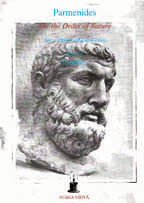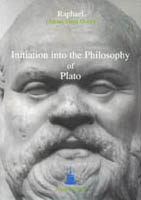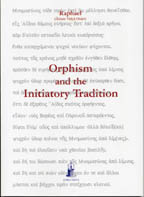|

Raphael
ORPHISM AND THE INITIATORY TRADITION
In this work Raphael highlights a fundamental point: with Orphism the Initiatory Tradition of the Mystery is established in Europe and therefore in the West. In other words, the Metaphysical vision of Being, which Parmenides, Pythagoras, Plato (and all the Philosophy following them) were to draw from, was the work of Orpheus and Orphism.
The Metaphysical vision of Orphism considers man formed of an immortal part (Soul), which is of a divine origin, and of a mortal one (body). The “fallen” Soul can be freed from its body-prison through a process of Initiation to the Mysteries capable of producing Realization. This was to change completely the conception of life and death throughout the West.
In addition, the author places Orphism in its traditional perspective, pointing out the metaphysical and initiatory aspects present in the two myths connected with Orpheus: his death and his “descent into Hades”.
Myths, says Raphael (a note also present in his Initiation to the Philosophy of Plato when discussing the “myth of the cave” and the “myth of Eros”), are not mere reveries, but contain the symbols and the cause of true experience, because they are cathartic experiences. If myths are knowledge expressed in a special form – because we recognize that the Supreme Truth cannot be empirically conceptualized or demonstrated – then they possess a universal value and are not confined to a particular or individual situation.
CONTENTS: Foreword – Introduction – Homer, Hesiod, Orpheus – Innovations of Orphism – Transmigration – The ultimate aim of the soul – Theogony – Universal order and harmony – The Orphic ascent – New aspects of the Orphic Mysteries.
approx. 140 pages
Parmenides
On the Order of Nature
For a Philosophical Ascesis
Edited by Raphael

The date of Parmenides birth is uncertain but, according to the indications of Apollodoros, it can be placed between the sixth and the fifth centuries B.C. Parmenides was born in Magna Graecia, in Elea (today’s Velia) located on the coast of Campania south of Paestum, into a family of noble lineage and quite well off. It is known that he governed and gave very good laws to his city (in those days, as it happened, cities were governed by Philosophers), and every year the Eleans pledged their loyalty to those laws. The Pythagorean Ameinias introduced Parmenides to the peace of contemplation, and because of this relationship, Parmenides himself is considered a Pythagorean.
The Eleatic constitutes a “beacon” whose light illumined Plato and even Aristotle, and consequently all the philosophers that followed.
Parmenides laid down several fundamental philosophical principles:
1. The Being as foundation of all the existent
2. The principle of identity, Being is identical to itself (Fr. 4; Fr. 8, 12, 25)
3. The principle of non-contradiction (Fr. 8, 15), which subsequently Aristotle also developed at both the logical and the epistemological level.
4. The principle of a-temporality or eternal present (Fr. 8, 3 and following), while the time aspect (becoming) he puts into d’oxa.
5. He has given an initiatory philosophical vision of an experimental order, therefore the Poem cannot leave this vision aside.
This implies that the human entity is put in the conditions to assimilate to Being, having the ontological dignity of it.
With Parmenides began what is called, in more specific terms, true Philosophy.
The initiatory way, or way of knowledge, is an active way in which it is recognized that the nature of Being is within us as well, as nous, essence. In terms of Vedanta it corresponds to paravidya (supreme knowledge). Parmenides received the initiation directly from the Goddess Dike. The other Goddesses mentioned in the Poem are characterizations, aspects or principles, which are refracted by the one Goddess who, in this case, represents the incarnation of the supreme Truth and the principial cause of manifestation.
The first part of the Poem, which is the most important part, appears to be complete, while that regarding the world of “appearances” is made up of only disconnected fragments, and at times there are just a few words, and therefore difficult to decipher and interpret.
In the field of Western Philosophy Parmenides’ influence can be noted by the following:
– A logical dialectical rigor in the exposition
– An existential vision addressed to the human entity
– A truth coming from on high and not empirically theorized or conceptualized by the dianoetic mind
Such a sacred vision can be revolutionary in a culture that, given the signs of the times, is characterized by a gloomy spiritual, ethical, cultural and political impoverishment.
CONTENTS: Introduction; The Way that leads to Being; Being; Introduction to the Proem; Fragment 1 – Proem; Fragments 2 – 7 Preamble to Fragment 8; Fragment 8; Introduction to the world of appearances; Fragments 8(contd.) – Notes to the Fragments; Bibliographic Reference; Glossary; Raphael: Unity of Tradition.
approx. 134 pages
Raphael
INITIATION TO THE PHILOSOPHY OF PLATO

Raphael underlines the fact that in Plato, just as in Orphism, we find a request for transcendence dictated by a precise goal: to take man back from the conflicting sensible world of phenomena to the Intelligible one, the true “Homeland” of Being. To this end, Plato has not only codified the fundamental principles of the traditional Teaching of the Mysteries in an admirable and unexceptionable conceptual form, but he has also proposed two operative paths that can lead to the realization of the Summum Bonum or One-Good: the path of Knowledge (Dialectics) and the path of Love or philosophical Eros.
Plato’s philosophy is not a subjective expression of opinions, but Knowledge as a result of seeing; a philosopher is “one who is able to see the Whole” and he who arrives at the contemplation of being in its entirety cannot but transform his way of thinking, willing and acting. Plato has revealed a Mystery Teaching of a traditional order that must be considered sacred and Raphael, going beyond the purely culturalist standpoint, proposes this approach to Plato’s Philosophy.
This work testifies to the consciousness identity attained by Raphael with Plato’s Teaching, as only he who has reached the “heart” of a Doctrine is able to express its essence with such Beauty.
Of particular interest is the chapter Platonism and Vedanta where precise points of correspondence between the philosophical visions of Plato and Shankara are made clear.
CONTENTS: Introduction – The sphere of Being or of Ideas – Unum-Bonum as the metaphysical Reality – Platonic dualism? – Dialectics as an awakening technique – The soul already knows Truth – Platonic mystical practice: cathartic Knowledge and Eros philosophical ascent – Shankara – Platonism and Vedanta.
approx. 160 pages
Raphael
THE PATH OF FIRE ACCORDING TO THE QABBALAH
’Ehjeh ’Aser ’Ehjeh (I Am Who I Am)
A Traditional Doctrine, if it is such, should not be a mere object of erudition, but an experience of life. This realization keynote is also to be found in the Qabbalah (Oral Tradition) which, like every true Branch of the Tradition, represents a complete Teaching, even though certain followers have dwelt and continue to dwell on some of its minor or particular aspects.
The symbol of the Qabbalah’s Teaching is the Sephirotic Tree which compendiates
the endless expressive possibilities of the micro and macro cosmos; the Sephiroth are in fact simply “ideas” or “modifications” of Kether-One, just as for Vedanta the universe is but a “modification” of Isvara. And just as in Advaita Vedanta we have the unqualified Brahman nirguna in the Qabbalah we have Ain-Soph-Aur. It is precisely this metaphysical sphere, which is usually not dealt with, that is brought to our attention by Raphael, and the disciple who is following the “Path of Fire” must have this sphere as his ultimate aim.
In the text a comparison is made between Vedanta and Qabbalah at various levels to show how the traditional Vision is One, while the variations are due merely to time and space factors.
CONTENTS: Foreword – The sephirotic Tree – Sex and Qabbalah – States of life – Sephirotic columns and triads – Path of Fire – Yesod-Hod-Nezach – Idea, number and name – The way of return – Chesed-Geburah-Tiphereth – Kether-Chokmah-Binah – Polarities – Metaphysical path – The soul according to the Qabbalah.
approx. 110 pages
|
|
|



